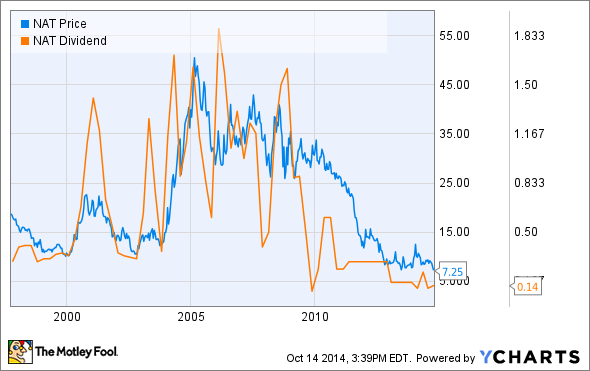
Source: Flickr user cuxclipper.
There is an ocean full of shipping stocks to invest in these days. Unfortunately, like the high seas, many of these stocks can be volatile enough to make you lose your lunch. That's why I prefer to invest in shipping stocks that offer less volatility along with a solid dividend yield. Topping that list are Seaspan Corporation (ATCO), Nordic American Tankers Ltd (NAT 0.27%), and Textainer Group Holdings Limited (TGH). Here's why.
A safer way to navigate the high seas
Like a lot of shipping stocks, Seaspan owns and manages a large fleet of ships, and it owns strictly containerships. However, where Seaspan parts ways from other shipping stocks is in its business model. Seaspan charters its vessels in long-term, fixed-rate time charters to major container liner companies. While it gives up some upside to prices, it makes that up in security of cash flow, enabling the company to steadily grow while paying out a very compelling 7.8% dividend.
As the following slide shows, Seaspan's 75 vessels have an average charter length of five years and the charters are staggered so that it only needs to manage a few renewals each year.

Source: Seaspan Corporation Investor Presentation.
This security enables Seaspan to weather almost any storm, as it won't be faced with a large number of renewals when charter or freight rates are weak. That makes it one solid shipping stock to invest in amid the sea of volatility that the industry is known to produce.
A focused way to ship oil
In one sense, Nordic American Tankers takes the opposite approach as Seaspan. It doesn't sign long-term charters with shippers. Instead, it leases its ships purely on the spot market as it seeks to take advantage of prices. This approach yields a highly volatile dividend and stock price, as we see in the following chart.
Still, even at the low end, this is a very high-yielding stock. And things get really compelling when we see Nordic American Tankers' operating leverage kick in. In order to mitigate risk and keep its costs low, Nordic only owns Suezmax vessels, with its current fleet up to 22 vessels. When spot prices are lower, the dividend is more modest. For example, if the spot rate average is $20,000 per day for the year, that will equate to about $0.60 in dividends per share being paid that year. However, when spot rates pick up and the operating leverage kicks in, the dividends really pick up. We see this when the spot rate doubles to $40,000, as the company's dividend for the year skyrockets to $2.40 per share. This solid dividend in weak times and incredible potential in good times is what makes Nordic American Tankers one of the best shipping stocks to invest in.
Staying on shore
The final shipping stock technically isn't a shipping stock. Textainer Group Holdings owns the shipping containers that are shipped on vessels like those owned by Seaspan. In fact, it's the world's largest lessor of containers, with more than 2 million under its control, which it leases out to around 400 shipping lines. Like Seaspan, its leases are mostly long-term in nature, with an average remaining lease term of 3.4 years. This provides stable cash flow so Textainer can pay a generous dividend to its investors.
This stability enables container leasing companies like Textainer to keep their heads above water when the economy begins to sink. As the following slide notes, leasing companies maintained a strong operating margin when the global economy went off the deep end in 2009, while container shipping lines lost money.

Source: Textainer Group Holdings Limited Investor Presentation.
The ability to maintain strong profitability during an economic storm is why Textainer makes a better "shipping stock" to invest in than most shipping stocks.
Stock prices of shipping companies can be as choppy as the ocean. That's why I prefer to invest in shipping stocks that focus on secure revenue sources like long-term leases and pay strong dividends or have extreme operating leverage to profit even in lean times. This takes away the stomach-churning volatility and replaces it with a more stable return.






